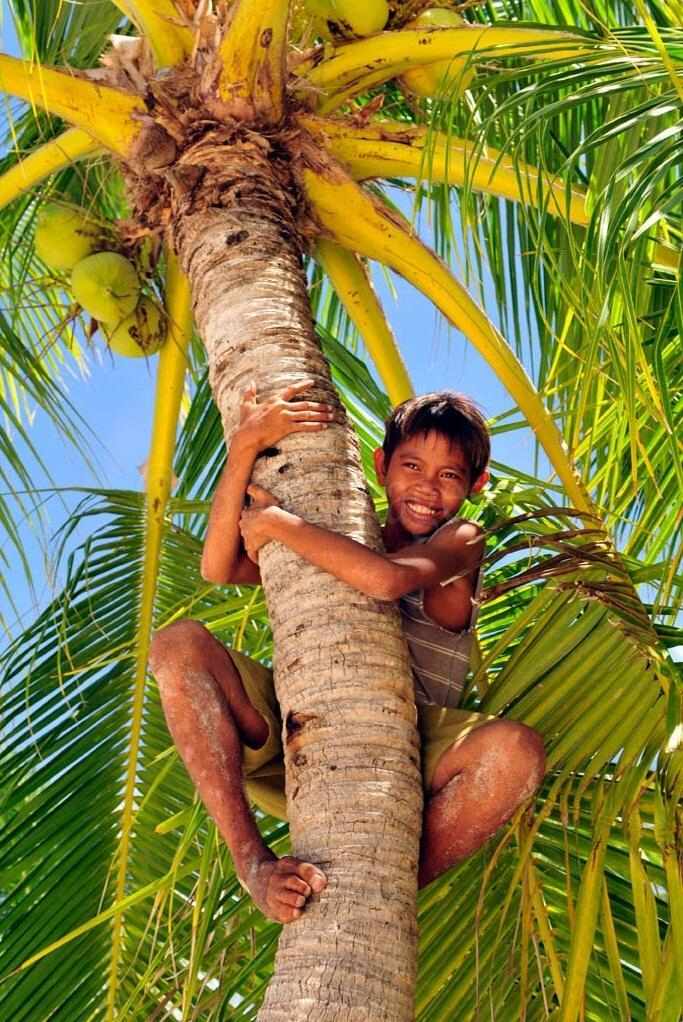
The Philippines Regions: The Center--Visayas

Figure 1.--This photo was taken on Malapascua Island in the Philippines. Malapascua is a small island located d in the Visayan Sea off the northern tip of Cebu Island. The name tranlatesas as 'bad Easter', although we are not sure just why. Here a local boy is climbing a coconut palm. Palm oil is an important part of the economy in Viscayas in general. The economy om Malpascua was once primarily devoted to fishing, but is now mostly dependant on tourism.
|
|
Visayas is the most diverse area of the Philippines. Unlike the north and south, there is no one dominant island. Visayas incluses includes a number of islands, The major islans from west to east are: Panay, Negros, Cebu, Bohol, Leyte, and Samar, but there are many smaller islands. Visayas is administratively divided into a Western, Central, and Easter Division. The first people settle Visayas were Austronesians and Negritos who migrated to the islands (beginning about 30,000 years ago), but continuing in arrivals of new groups for thousabnds of years (Until about 6,000 years ago). These were small animist tribal groups. A new ethnic and cultural group began arriving in the modern era, refugees from the collapsing empires of Srivijaya, Majapahit and Brunei (12th cebtury AD). They were led led by Datu Puti and his tribal followers. They primarily settled on Panay and its many small surrounding islands. Panay is located southeast of Mindoro and northwest of Negros. (The USS Panay sunk by the Japanese in n incident before World War II was named after Panay. Arab traders operating in the Malay and Indonesian Archepelago reached Vicayas (14th century). They converted some tribal groups to Islam, although religious practices tended to be a mixture of Islam and animism. There is also evidence of trade with other areas of Asia and the pricipalities developing what is now Indinesia ana Malaysia. The first Europeans to reach Visayas and the Philippines was Ferdinand Magellan who landed on Cebu (1521). He found that locals were able to converse in Malay. It was Spain who actually colonized the Philippines. King Philip II of Spain dispatched two expeditions, Ruy López de Villalobos (1543) and Miguel López de Legazpi (1543). The islands were named after Philip. Under Spanish control, tribal groups in Visayas began converting to Christianity and adopting a westenized culture. Gradually resistance to Spanish ruke began to build. An early leader in the Visayas area was Francisco Dagohoy. Negros was an important part of the Filipino resistance to the Spanish and played a role in the Philippine–American War (1898-1913). The World War II Battle of Leyte Gulf was the greatest navaln battle in history. It was followed by heavy ground fighting on Leyte.
HBC

Navigate the Boys' Historical Clothing Web Site:
[Return to the Main Philippines regions page]
[Return to the Main Philippines page]
[Return to the Main Oceania page]
[Return to the Main countries page]
[Introduction]
[Activities]
[Biographies]
[Chronology]
[Cloth and textiles]
[Clothing styles]
[Countries]
[Topics]
[Bibliographies]
[Contributions]
[FAQs]
[Glossaries]
[Images]
[Links]
[Registration]
[Tools]
[Boys' Clothing Home]
Created: 10:13 PM 1/29/2011
Last updated: 10:13 PM 1/29/2011



